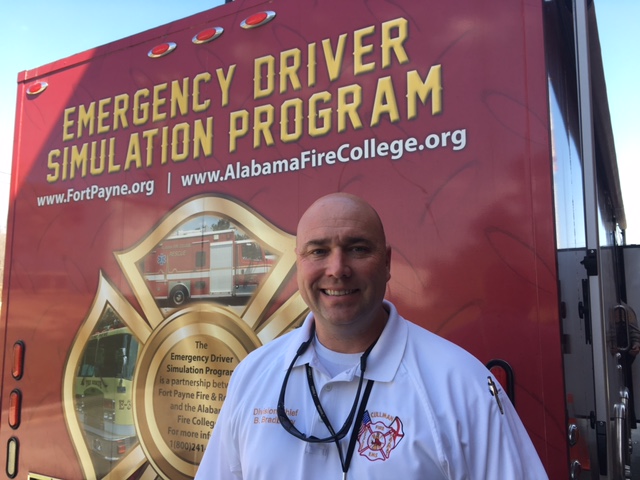Cullman Fire Rescue Division Chief Brian Bradberry stands outside the simulator
CULLMAN – It takes more than a driver’s license and a badge to drive an emergency vehicle. It takes lengthy training (Cullman firefighters will be on the job for three years before they even get to try,) and lots of practice. This week Cullman area emergency responders got the opportunity to practice driving a wide variety of vehicles under different (sometimes dangerous) circumstances without burning gas or endangering people and property, thanks to a loan from the Alabama Fire College.
The college’s Emergency Driver Simulation Program, a self-contained portable training trailer with two complete vehicle cockpits, rolled into Cullman and spent several days in operation at the city’s Fire Station No. 2. The program places drivers behind the wheel with five large wrap-around computer screens, and simulates several different types of large fire trucks, ambulances, fire and police SUVs, and police cars, along with Humvees, dump trucks and even school buses. A supervisor can, from a separate work station, change weather and road conditions, place obstacles like vehicles and pedestrians in the driver’s path, and even blow out selected tires or cause engine trouble in the vehicle to create challenging real-world scenarios.
Simulator Supervisor Brandon Williams said, “I think one person could stay on one simulator and work three or four hours, and not hit the same scenario twice.”
Close to 200 area firefighters, EMTs and law enforcement officers came to drive in simulated scenarios, and were afterwards able to view their results to see strengths and weaknesses of their driving techniques. They could even take home printouts of their results, to help focus future training and practice efforts.
Cullman Fire Rescue Division Chief of Training and Safety Brian Bradberry explained the benefits of this training, “At the end of every scenario, you get a printout of how well you did, and (it) give(s) you stuff to work on. Sometimes people don’t realize they’re doing something; so, it’s a good evaluation tool.”
Caution: Reporter behind the wheel!
Bradberry and Williams offered to let me try out the simulator, and of course I accepted. The simulator had a realistic feel, with a complete driver’s cockpit and a full array of controls arranged as a fire truck driver would expect to find them. The five large screens gave me a 180-degree field of vision, and rear-view mirrors in the side screen projections even showed me what would be behind me. And of course, I got to turn on the siren and blow the air horn.
Williams put me in a large fire truck, and sent me out to locate a fire in an urban setting, as Bradberry explained that responders don’t always have an exact address when they leave the station. Neither the officers nor I could find the fire (Williams said that occasional false alarms were part of the program), but my results were pretty good. Apparently, I should have used my air horn and (more importantly) brakes a little more, but I made it through okay.
Then Williams sent me out in the county to respond to a barn fire on a farm. I was doing well, locating the fire and avoiding a big rigger who had a total lack of regard for both emergency vehicles and stop signs. Bradberry even gave me a “good job” over my shoulder. I was within sight of the fire and feeling pretty good about myself when a tractor came out of the cornfield into the road in front of me. I didn’t ask about my score on that one.
Bradberry shared that training opportunities like this are part of the regular duties of emergency responders, “A lot of people don’t realize this, but firefighters train a lot. Between this (fire service) and EMS, individually they’ll train over 300 hours a year. There’s a lot of different divisions in fire service: rope rescue, EMS, fire, vehicle extrications, structural collapse, confined space, water rescue. Some of these things we don’t get dispatched on very often, but when we do we still have to know how to deal with it. These guys have a lot of responsibility, and do a real good job.”
Learn more about the program at www.AlabamaFireCollege.org.
Copyright 2017 Humble Roots, LLC. All Rights Reserved.





















